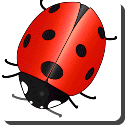 Ladybug — Coccinellidae is a family of beetles, known variously as ladybirds (British English, Australian English, South African English), ladybugs (North American English) or lady beetles (preferred by some scientists). The family name comes from its type genus, Coccinella. Coccinellids are found worldwide, with over 5,000 species described, more than 450 native to North America alone. Coccinellids are small insects, ranging from 1 mm to 10 mm (0.04 to 0.4 inches), and are commonly yellow, orange, or scarlet with small black spots on their wing covers, with black legs, head and antennae. A very large number of species are mostly or entirely black, gray, or brown, however, and may be difficult for non-entomologists to recognize as coccinellids (and, conversely, there are many small beetles that are easily mistaken as such, like tortoise beetles).
Ladybug — Coccinellidae is a family of beetles, known variously as ladybirds (British English, Australian English, South African English), ladybugs (North American English) or lady beetles (preferred by some scientists). The family name comes from its type genus, Coccinella. Coccinellids are found worldwide, with over 5,000 species described, more than 450 native to North America alone. Coccinellids are small insects, ranging from 1 mm to 10 mm (0.04 to 0.4 inches), and are commonly yellow, orange, or scarlet with small black spots on their wing covers, with black legs, head and antennae. A very large number of species are mostly or entirely black, gray, or brown, however, and may be difficult for non-entomologists to recognize as coccinellids (and, conversely, there are many small beetles that are easily mistaken as such, like tortoise beetles).
They are generally considered useful insects as many species feed on aphids or scale insects, which are pests in gardens, agricultural fields, orchards, and similar places. Some people consider seeing them or having them land on one’s body to be a sign of good luck to come, and that killing them presages bad luck. A few species are pests in North America and Europe.
Coccinellids are often brightly coloured to ward away potential predators. This defense works because most predators associate bright colours (especially orange and black or yellow and black) with poison and other unpleasant properties. This phenomenon is called aposematism. In fact, most coccinellids are indeed poisonous to smaller predators, such as lizards and small birds; however, a human would have to eat several hundred coccinellids before feeling any effects.
Most Coccinellids mate in Spring or Summer and the female lays a cluster of eggs (numbering from a few to a few hundred, depending on species) as near as possible to an aphid colony. In most species these eggs hatch into a larval state within a week. This state lasts 10–15 days, and they then go into a pupal stage before becoming an adult coccinellid. The entire life cycle of the Coccinellid is only 4–7 weeks. Most ladybird species are univoltine, producing only one generation a year, although some are bivoltine.
Most coccinellids are beneficial to gardeners in general. In the Spring, one could usually find a ladybird in a vegetable garden feeding on aphids. As in many insects, ladybirds in temperate regions enter diapause during the Winter. Some species (e.g., Hippodamia convergens) gather into groups and move to higher land, such as a mountain, to enter diapause. Ladybirds are usually found where aphids or scale insects are, and they lay their eggs near their prey, to increase the likelihood the larvae will find the prey easily. Since aphids and scale insects occur nearly everywhere in the world, ladybirds are also cosmopolitan.
 Kids Portal For Parents India Kids Network
Kids Portal For Parents India Kids Network
